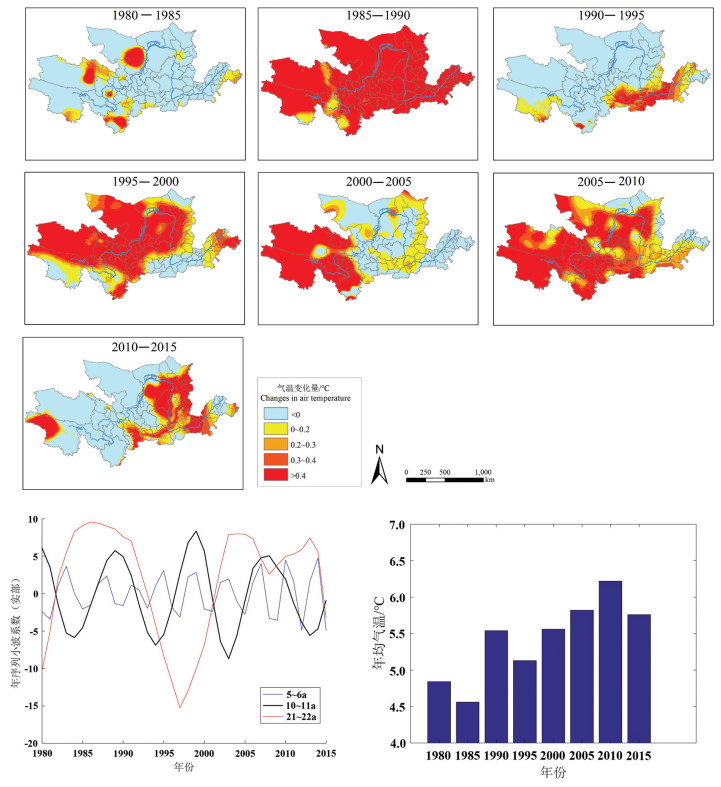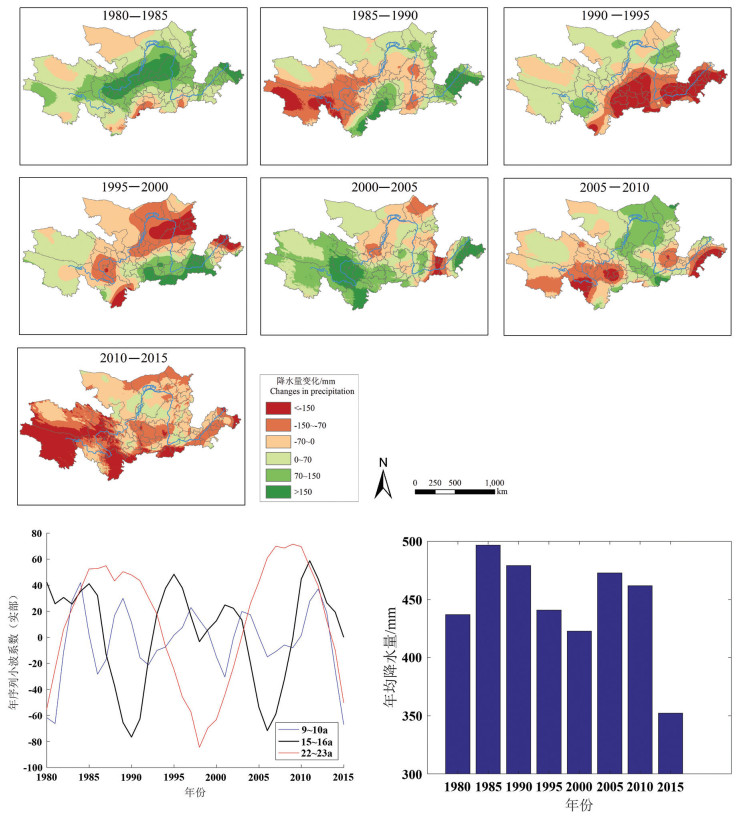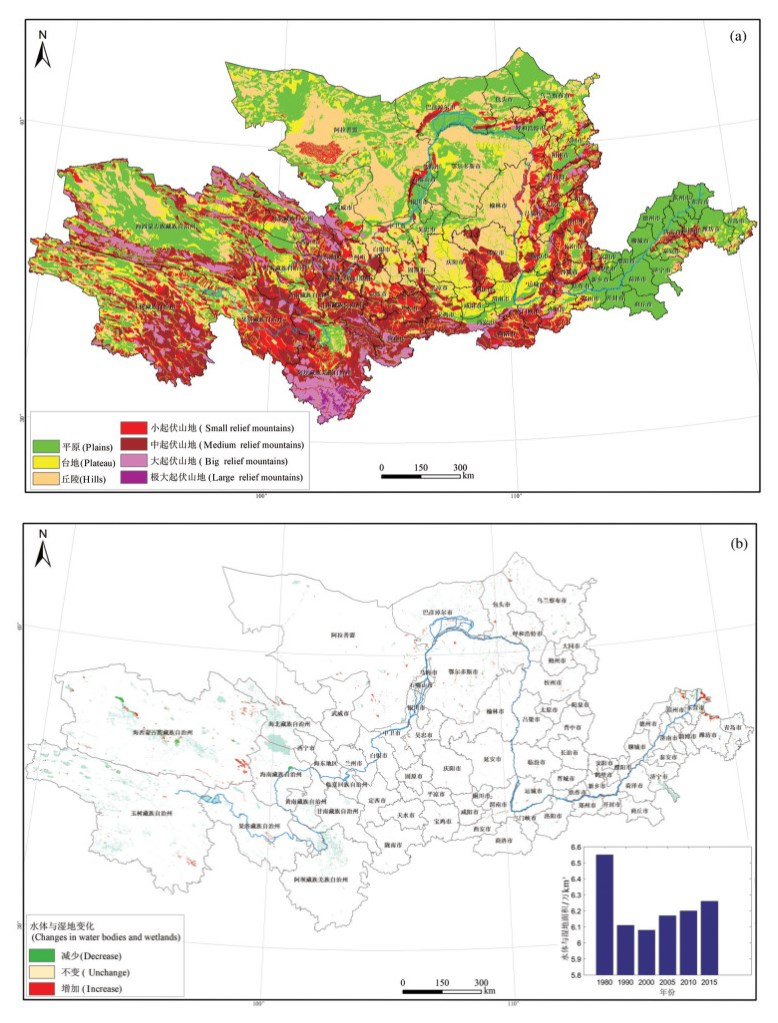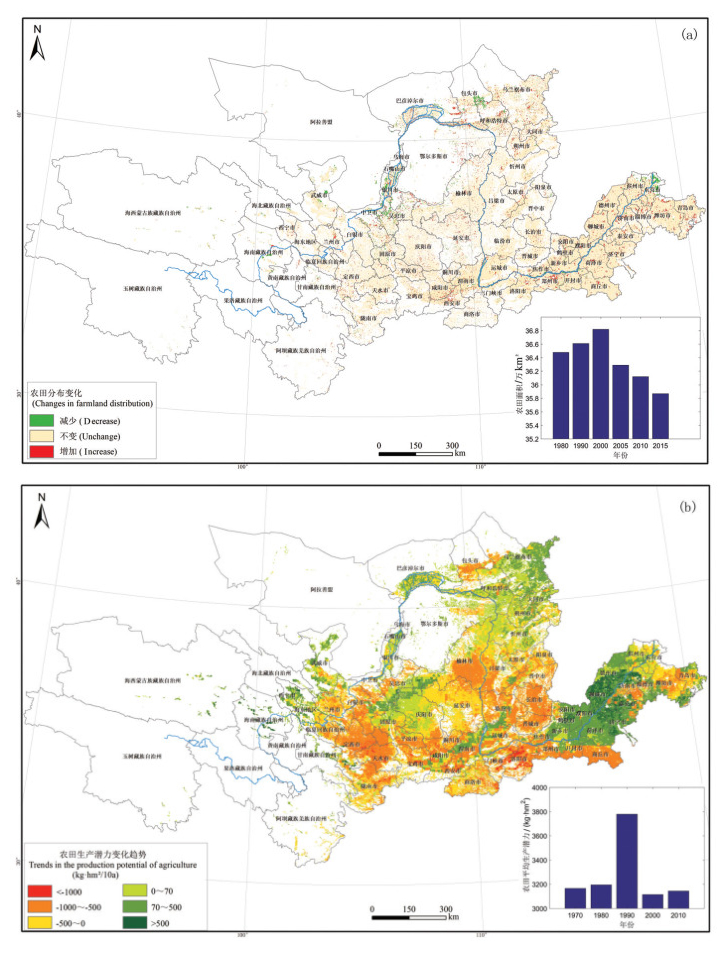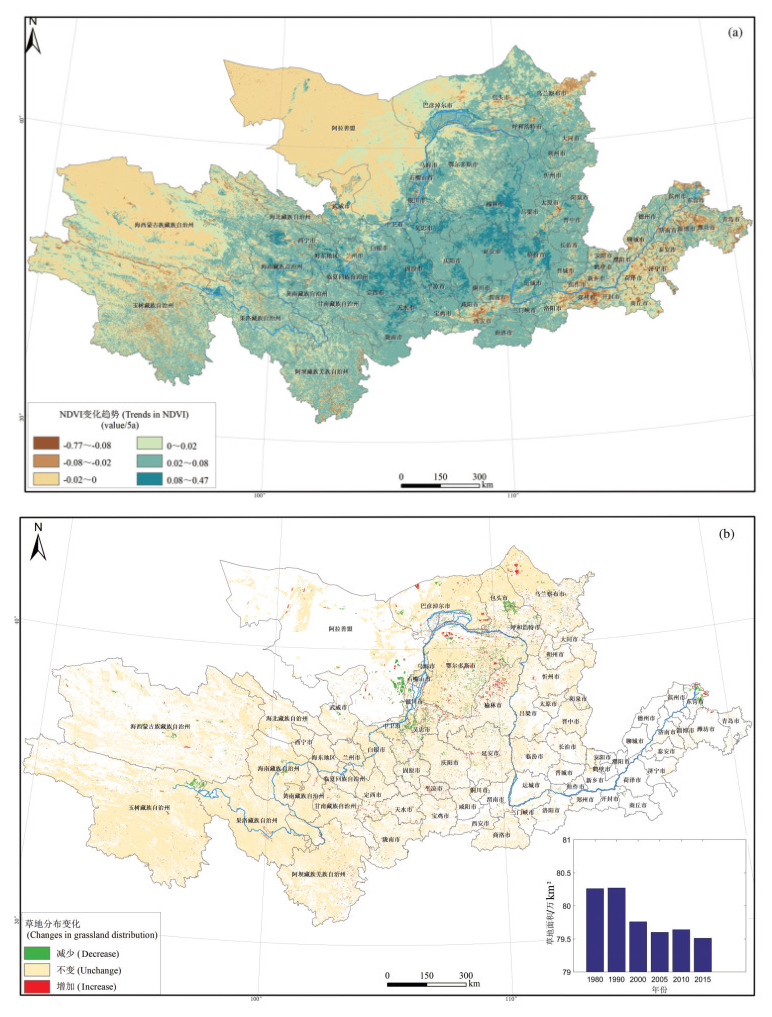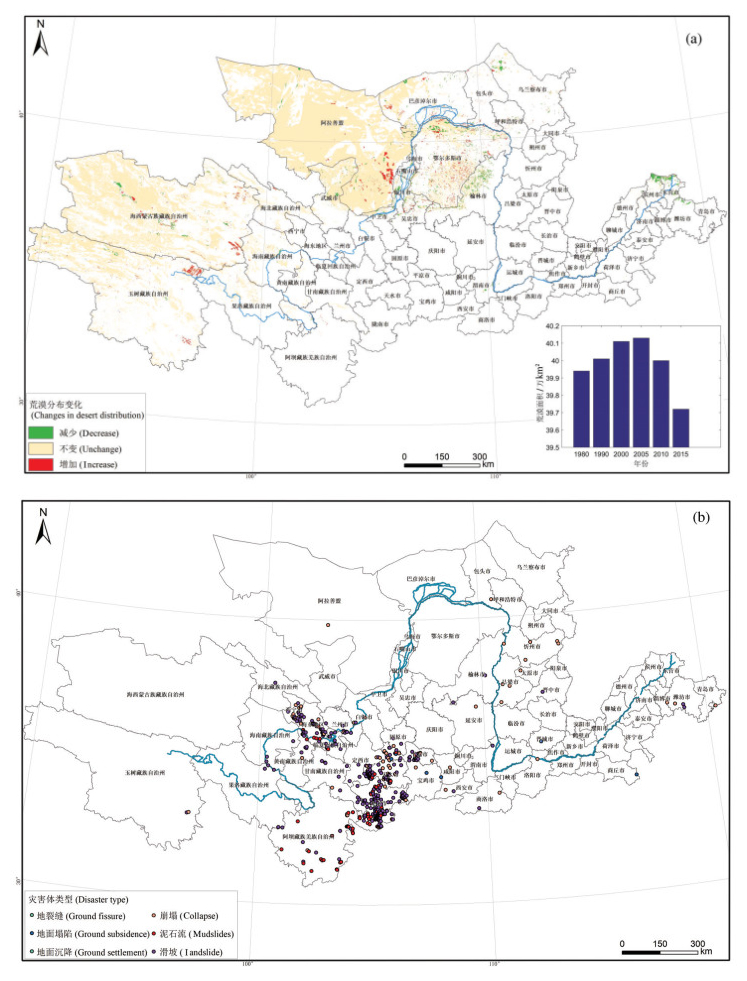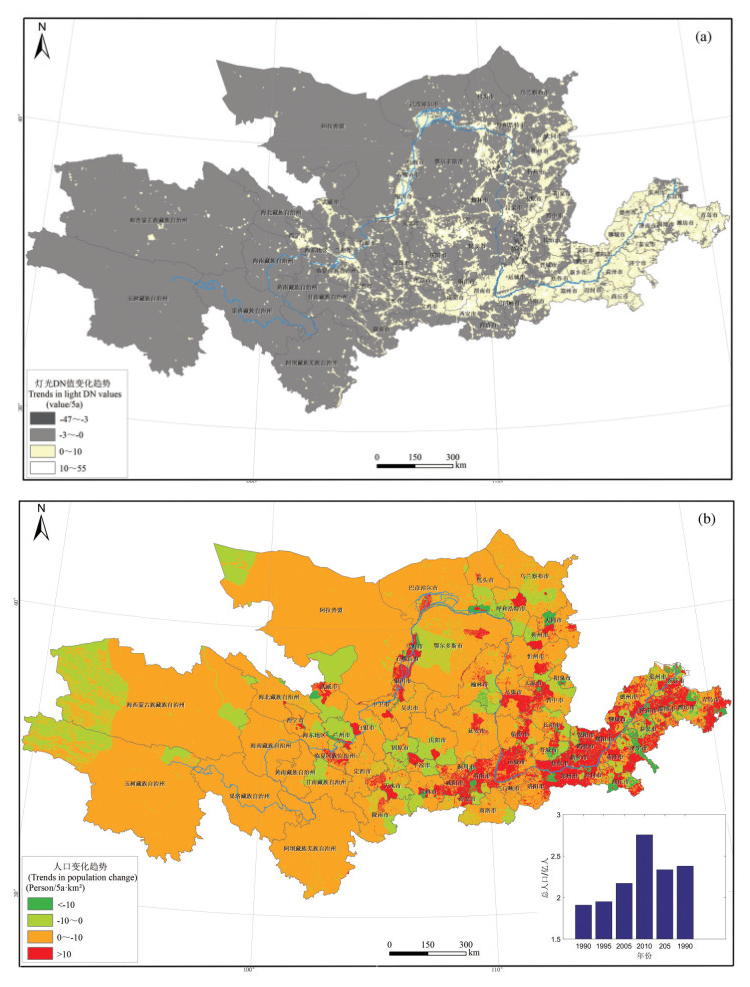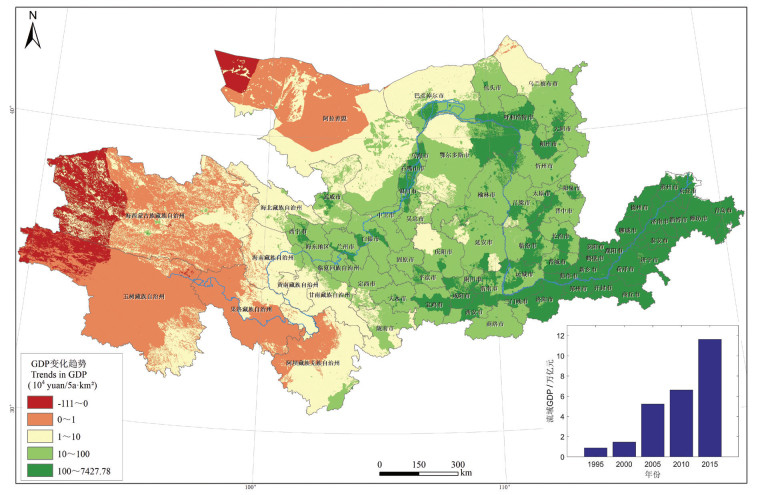Changes of resource and environmental pattern of the Yellow River Basin in the past 40 years and suggestions on geological work
-
摘要:
20世纪80年代以来,自然演变与强烈的人类活动叠加,致使黄河流域资源环境格局发生了显著变化,进而影响其开发利用布局,面临诸多资源短缺、环境退化和生态破坏问题,急需从地球系统科学的视角深入研究流域资源环境的格局变化特点,识别重大资源环境问题,提出解决方案,为黄河流域可持续发展提供决策依据。本研究以"山水林田湖草"生命共同体理念和地球系统科学理论为指导,利用多源多时相调查研究数据,分析黄河流域1970-2015年近40年气候、山区、水文等十一大类资源环境格局变化及区域分异规律,识别重大地质资源环境问题,提出地质工作建议。研究结果表明:黄河流域气候整体暖干化趋势明显,局部出现暖湿现象;山区生态系统脆弱、逐步恢复,局部人类活动影响剧烈;水体与湿地面积总体减少,近年呈增加趋势,径流量呈减少趋势,部分干支流污染严重,水生生物多样性减少;农田面积呈下降趋势,下游地区农田生产潜力增加明显;植被覆盖呈现整体缓慢升高、局部退化趋势;草地面积持续减少,草地生态系统退化明显;荒漠化扩展态势得到遏制,总体形势依然严峻;自然灾害频发,水害严重,地质灾害聚集分布,形成陇中黄土高原和陇南山地两个高发区;城镇建设用地面积持续上升,由下游地区向中上游扩散,中上游呈现出由轴线连接的多个核心的组团分布特征;人口分布重心进一步向东偏离,沿中心城市、干流、交通干线增加;GDP整体呈现上涨趋势,呈现由东向西递减、由干流或主支流沿岸向两边递减、由中心城市向周围递减。为保护黄河流域生态环境、促进高质量发展,解决黄河流域面临的复杂多样的地质资源环境问题,建议地质工作以地球系统科学理论为指导对黄河流域重大地质资源环境问题进行系统调查研究;以地球系统科学研究方法为框架,进行跨学科协作,整合区域性地质调查工作。
Abstract:Since the 1980s, natural evolution and intense human activities have superimposed a significant change in the pattern of resources and environment in the Yellow River Basin, which further affects its development and utilization distribution and leads to a lot of problems such as resource shortage, environmental degradation and ecological destruction. From the perspective of earth system science, it is urgent to study the changes of the resources and environment pattern in the Yellow River Basin, identify major resources and environment problems, and put forward solutions, so as to provide decision-making basis for the sustainable development of the Yellow River Basin. With "life community of mountains, rivers, forests, fields, lakes and grasses" concept and earth system science theory as the instruction, according to the investigation of multisource and multiphase data, this paper analyzes the changes in eleven major resources environmental patterns and regional differentiation in the Yellow River Basin in the last 40 years from 1970 to 2015, including climate, mountainous area and hydrology, identifies the major geological resources and environment problems, and advances some suggestions on the geological work. The results show that the climate of the Yellow River Basin as a whole has an obvious trend of warming and drying, and the phenomenon of warming and humidity appears locally. In recent years, the total area of water and wetland has been decreasing, and the runoff has been decreasing. Some of the main tributaries are seriously polluted, and the aquatic biodiversity has been reduced. In addition, the mountain ecosystem is fragile and gradually restored, the impact of local human activities is intense, the farmland area shows a downward trend, and the farmland production potential in the downstream area is increasing obviously. Moreover, vegetation cover shows a slow increase trend and local degradation, grassland area continues to decrease, grassland ecosystem degradation is obvious, the trend of desertification expansion has been contained, and the overall situation is still grim. In this case, frequent natural disasters, serious water disasters and concentrated geological disasters have led to the formation of such two high incidence areas in southern Gansu as Loess Plateau and Mountains. The continuous rise of urban construction land area leads to the spread of land area from the downstream area to the middle and upper reaches, which shows the cluster distribution characteristics of multiple construction land cores connected by axes. As a result, the center of population distribution further deviates to the east and increases along the central city, trunk stream and traffic lines. The overall GDP shows an upward trend, but manifests a decline from east to west, from the main stream or tributary coast to both sides and from the central city to the surrounding. In order to protect the ecological environment of the Yellow River Basin, promote the high-quality development and solve the diverse geological resources and environmental problems, it is suggested that geological work should be guided by the theory of earth system science to carry out systematic investigation and research on the major geological resources and environmental problems of the Yellow River Basin. Based on the research method of earth system science, we should carry out interdisciplinary cooperation and integrate regional geological survey.
-
-
-
В.Т.Трофимов, Liu Baiqiu. 1995. The stability and influencing factors of geological environment[J]. Journal of Geological Sciences, (2):90-92.
Blatt H. 2011. America's environmental report card:Are we making the grade?[M]. MIT Press.
Cao Wenhong. 2003. Promoting water-saving soil and water Conservation in loess Plateau region[J]. Chinese Science of Soil and Water Conservation, (1):41-44(in Chinese with English abstract).
Chen Qiong, Zhang Ytterbium Li, Liu Fenggui, Zhou Qiang, Wang Shengzhen, Cheng Yi, Guo Rong, Zhi Zemin, Xu Huange. 2020. Research review on land use change and its impact in the headwaters of the Yellow River Basin[J]. Resources Science, 42(3):446-459(in Chinese with English abstract).
Chen Yingyu, Wang Yonggui, Zhou Xiangyang. 2008. Desertification status and driving force of the source area of the Yellow River[J]. Journal of Qinghai University (Natural Science edition), (4):71-76, 80(in Chinese with English abstract).
Chen Zhikun, Zhang Shuyu, Luo Jiali, Li Zhaorong. 2013. Climatic analysis of precipitation anomalies in northwest China[J]. China Desert, 33(6):1874-1883(in Chinese with English abstract).
Dong Suocheng, Zhou Changjin, Wang Haiying 2002. Major Ecological environmental problems and countermeasures in the "Three River Sources" area[J]. Journal of Natural Resources, (6):713-720(in Chinese with English abstract).
Du Jiaju, Chen Zhiwei. 2010. Path analysis using SPSS linear regression[J]. Biology Bulletin, 45(2):4-6(in Chinese with English abstract). http://d.old.wanfangdata.com.cn/Periodical/swxtb201002002
Du Jizeng, Wang Genxu, Li Yuanshou. 2015. Analysis on the characteristics and causes of alpine grassland degradation in the source area of the Yangtze and Yellow River in recent 45 years[J]. Acta Ecologica Sinica, 24(06):5-15(in Chinese with English abstract).
Fang Zhi, Xu Weihua, Zhang Jingjing, Xiao Yi, Zhang Lu. 2017. Planning of nature conservation system of qinling Ridge System based on biodiversity and ecosystem service function[J]. Acta Ecologica Sinica, 37(16):5334-5341(in Chinese with English abstract). http://en.cnki.com.cn/Article_en/CJFDTotal-STXB201716008.htm
Guo Jia, Wei Wei, Yu Yilei, Song Xiangjing, Zhang Manyin, Li Shengnan. 2015. Research progress on eutrophication of Wuliangsu Sea Wetland[J]. Journal of Ecology, 34(11):3244-3252(in Chinese with English abstract).
Han Dayong, Yang Yongxing, Yang Yang, Li Ke. 2012. Research progress on wetland degradation[J]. Acta Ecologica Sinica, 32(4):289-303(in Chinese with English abstract).
Huang Qi. 2012. GIS Based Study on Ecological Environment Change and Human Activities in Sanjiangyuan Area[D]. Beijing: Minzu University of China(in Chinese with English abstract).
IPCC. 2014. Climate Change 2014: impacts, Adaptation, and Vulnerability: Part A[R]. Cambridge, UK: Cambridge University Press: 1132(in Chinese with English abstract).
Jiang Lianjie. 2006. Analysis of water pollution in the Yellow River basin and water environment protection measures[J]. Water Resources Protection, (1):64-67(in Chinese with English abstract).
Li Hongchao, Sun Yongjun, Li Xiaoqin, Bi Erping. 2013. Desertification characteristics and influencing factors in the middle reaches of the Yellow River[J]. Remote Sensing of Land Resources, 25(2):143-148(in Chinese with English abstract).
Li Renshi, Shao Zhitao, Zhang Honghong, An Zhihong. 2014. Spatiotemporal evolution and causes of desertification in the Upper Yellow River in recent 30 years[J]. World Geology, 33(2):494-503(in Chinese with English abstract).
Li Shuai. 2015. Climate and Land Use Change and Its Impact on Runoff in Ningxia Yellow River Basin[D]. Chongqing: Southwest University(in Chinese with English abstract).
Li Yuhong, Shang Xiaocheng. 2001. Analysis on the current situation and change of the pollutant carrying capacity of the Yellow River trunk Stream[J]. Water Resources Protection, (1):41-44, 62(in Chinese with English abstract).
Lian Luharre, Liu Binhui.2019. Variation characteristics of dry and wet periods in northwest China in recent 58 a[J]. Arid Region Geography, 42(06):1301-1309(in Chinese with English abstract). http://en.cnki.com.cn/Article_en/CJFDTotal-GHDL201906008.htm
Liu Dexiang, Dong Anxiang, Deng Zhenyong. 2005. Effects of climate warming on agriculture in northwest China[J]. Journal of Natural Resources, (1):119-125(in Chinese with English abstract).
Lü Zhenyu, Mu Jianxin. 2017. Study on the temporal and spatial evolution characteristics of water pollution in the Yellow River Basin[J]. People's Yellow River, 39(4):66-70, 77(in Chinese with English abstract).
Ma Guanghui. 2007. Impact of Water Resources Development and Utilization on Hydrological Cycle and Ecological Environment in the Yellow River Basin[D]. Nanjing: Hohai University(in Chinese with English abstract).
Pan Jinglu. 2013. Impact of Habitat Pressure Development on Biodiversity Conservation in Qinling Mountains[D]. Beijing: Beijing Forestry University(in Chinese with English abstract).
Pei Yixuan, Guo min. 2001. Basic principle and application of moving average method[J]. Journal of Gun Launching and Control, (1):21-23(in Chinese with English abstract).
Peng Bo, Ge Lei, Wang Ruiling, Liu Bo, Lou Guangyan, Huang Wenhai. 2015. Simulation analysis of the impact of Ecological replenishment on groundwater of Diaokou River in the Yellow River Delta[J]. Water Resources Protection, 31(5):1-6(in Chinese with English abstract). http://en.cnki.com.cn/Article_en/CJFDTOTAL-SZYB201505001.htm
Ren Jingyu, Zhao Junxia, Ma Hongbin, Peng Shouzhang, Li Bingyin. 2019. Prediction of temporal and spatial distribution trend of climate change in four seasons in the Loess Plateau from 2015-2100[J]. Soil and Water Conservation Bulletin, 39(05):262-271, 347-348(in Chinese with English abstract). http://en.cnki.com.cn/Article_en/CJFDTotal-STTB201905037.htm
Shen Fang, Huang Run Qiu, Miao Fang, Luo Wenqiang. 1999. GIS technology for regional geological environment assessment and disaster prediction[J]. Acta Monolinica Sinica, (4):338-342(in Chinese with English abstract).
Shen huaifei. 2007. Landscape Pattern Change of the Yellow River Basin in Western Henan Province Based on 3S[D]. Kaifeng: Henan University(in Chinese with English abstract).
Shen Zhenyao, Yang Zhifeng, Cao Yu. 2003. Review of environmental vulnerability research[J]. Geoscience and Technology Information, (3):91-94(in Chinese with English abstract). http://www.en.cnki.com.cn/Article_en/CJFDTOTAL-DZKQ200303018.htm
Shi Jianguo, Yan Changrong, he Wenqing, Liu Keli. 2008. Study on temporal and spatial pattern of water deficit in the Yellow River Basin[J]. Journal of Natural Resources, (1):113-119(in Chinese with English abstract).
Tian Hong, Li Chun, Zhang Shiyang. 2005. Climate change in the Yangtze Huaihe River Basin in recent 50 years[J]. Journal of Ocean University of China (Natural Science Edition), (4):539-544(in Chinese with English abstract). http://www.cqvip.com/Main/Detail.aspx?id=1001178050
Tian Zhizhi, Zhang Dandan, He Xiaohui, Guo Hengliang, Wei Haitao. 2019. Temporal and spatial variation characteristics of vegetation net primary productivity and its driving factors in the Yellow River Basin from 2000 to 2015[J]. Soil and Water Conservation, 26(2):255-262(in Chinese with English abstract).
Wang Fang. 2012. Research on Ecological Asset Valuation of Qilian Mountain Nature Reserve[D]. Lanzhou: Lanzhou University(in Chinese with English abstract).
Wang Guan, Zhang Kai, Liu Jing. 2020. Is Northwest China warming and getting wet?[J]. Ecological Economy, 36(1):9-12(in Chinese with English abstract).
Wang Yao, Zhang Mao, Yang Jianfeng. 2019. Vulnerability assessment of geological environment in China[J]. Northwest Geology, 52(2):198-206(in Chinese with English abstract).
Wang Youkui, Guo Shengxiang, Wang Jie, Yuan Hong, Xu Berin, Wang Doyao. 2013. Evaluation of forest ecosystem Service value in Qilian Mountain National Nature Reserve, Gansu[J]. China Desert, 33(6):1905-1911(in Chinese with English abstract). http://en.cnki.com.cn/Article_en/CJFDTOTAL-ZGSS201306042.htm
Wang Yao, Chen Ruishan, Xia Zilong, Guo Chihui. 2020. The evaluation of ecosystem service value and its spatial change in the Yellow River Basin and suggestions from the ecological geology perspectives[J].Geological Bulletin of China, 39(10):1650-1662(in Chinese with English abstract).
Wen Qingke, Zhang Zengxiang, Xu Jinyong, Zuo Lijun, Wang Xiao, Liu Bin, Zhao Xiaoli, Yi Ling. 2011. Remote sensing monitoring and analysis of temporal and spatial pattern changes of coastal wetlands around Bohai Sea[J]. Acta Remote Sensing, 15(1):183-200(in Chinese with English abstract).
Wu Shaohong, Zhao Yan, Tang Qiuhong, Zheng Jingyun, Gao Jiangbo, Liang Tao. 2015. Land surface pattern research for the future Earth project[J]. Progress in Geographic Sciences, 34(1):10-17(in Chinese with English abstract). http://en.cnki.com.cn/Article_en/CJFDTOTAL-DLKJ201501002.htm
Wu Shaohong, Zhao Zongci. 2009. The latest scientific cognition of climate change and water[J]. Climate Change Research Progress, 5(3):125-133(in Chinese with English abstract).
Xi Jinping. 2019. Speech at the symposium on ecological protection and high-quality development in the Yellow River Basin[J]. Water Resources Development and Management, (11):1-4(in Chinese with English abstract).
Xie Gaodai, Zhang Caixia, Zhang Changshun. 2015. Value of ecosystem services in China[J]. Resource Science, 37(9):1740-1746(in Chinese with English abstract). http://www.onacademic.com/detail/journal_1000034415111610_b6bb.html
Xu zongxue, Zhang Nan. 2006. Analysis of precipitation change trend in the Yellow River Basin in recent 50 years[J]. Geographic Research, (1):27-34(in Chinese with English abstract). http://en.cnki.com.cn/Article_en/CJFDTOTAL-DLYJ200601003.htm
Yang Jinhu, Jiang Zhihong, Liu Xiaoyun, Yue Ping. 2012. Analysis of dry-wet evolution and sustainable characteristics in northwest China in the past half century[J]. Arid Region Geography, 35(1):10-22(in Chinese with English abstract).
Yang Wei, Pei Jun, Li Xiaoxiao, Sun Tao, Wang Wenyan. 2018. Systematic evaluation and countermeasures on ecological restoration effect of degraded wetlands in the Yellow River Delta[J]. Journal of Beijing Normal University (Natural Science edition), 54(1):98-103(in Chinese with English abstract).
Zhang Lijun.2005. Vulnerability assessment of geological environment for mineral resource exploitation in Qinghai Province based on GIS multi-criterion spatial analysis (SMCE)[J]. Geology in China, 32(3):518-522(in Chinese with English abstract). http://www.cnki.com.cn/Article/CJFDTotal-ZYSY2005S1049.htm
Zhang Peilan, Wang Hao, Lei Xiaohui, Wang Xu. 2017. A review of studies on wetland ecological replenishment[J]. People's Yellow River, 39(9):64-69(in Chinese with English abstract).
Zhang Qiang, Zhang Cunjie, Bai Huzhi, Li Lin, Sun Landong, Liu Dexiang, Wang Jinsong, Zhao Hongyan. 2010. New dynamics of climate change in northwest China and its impact on drought Environment——overall warming and drying, and signs of local warming and humidity[J]. Drought Meteorology, 28(1):1-7(in Chinese with English abstract).
Zhang Yangzheng, Liu Jing, Lu Fang. 2014. Discussion on ecological replenishment of Wetland in Yellow River Delta[C]//Chinese Society of Water Resources(in Chinese with English abstract).
Zhang YTterbium Li, Liu Linshan, Bai Wanqi, Shen Zhenxi, Yan Jianzhong, Ding Mingjun, Li Shuangcheng, Zheng Du. 2006. Spatial characteristics of grassland degradation in the source area of the Yellow River[J]. Acta Geographica Sinica, (1):3-14(in Chinese with English abstract). http://d.old.wanfangdata.com.cn/Periodical_dlxb-e200602001.aspx
Zhao Xinquan, Zhou Huakun. 2005. Ecological environmental degradation, restoration and governance and sustainable development in Sanjiangyuan District[J]. Journal of Chinese Academy of Sciences, (6):37-42(in Chinese with English abstract).
Zhuo Junling, Ge Lei, Shi Xueting. 2013. Study on ecological replenishment of freshwater Wetland at the mouth of Yellow River[J]. Journal of Water Ecology, 34(2):14-21(in Chinese with English abstract).
В.Т.Трофимов, 刘柏秋. 1995.地质环境稳定性及其影响因素[J].地质科学译丛, (2):90-92. https://www.cnki.com.cn/Article/CJFDTOTAL-BSHB199502021.htm 曹文洪. 2003.黄土高原地区提倡节水型水土保持[J].中国水土保持科学, (1):41-44. doi: 10.3969/j.issn.1672-3007.2003.01.011 陈琼, 张镱锂, 刘峰贵, 周强, 汪生珍, 成艺, 郭蓉, 支泽民, 许寰戈. 2020.黄河流域河源区土地利用变化及其影响研究综述[J].资源科学, 42(3):446-459. https://www.cnki.com.cn/Article/CJFDTOTAL-ZRZY202003004.htm 陈英玉, 王永贵, 周向阳. 2008.黄河源区荒漠化现状及其驱动力研究[J].青海大学学报(自然科学版), (4):71-76+80. doi: 10.3969/j.issn.1006-8996.2008.04.019 陈志昆, 张书余, 雒佳丽, 李照荣.2013.中国西北地区降水异常的气候分析[J].中国沙漠, 33(6):1874-1883. https://www.cnki.com.cn/Article/CJFDTOTAL-ZGSS201306038.htm 董锁成, 周长进, 王海英2002. "三江源"地区主要生态环境问题与对策[J].自然资源学报, (6):713-720. doi: 10.3321/j.issn:1000-3037.2002.06.009 杜际增, 王根绪, 李元寿. 2015.近45年长江黄河源区高寒草地退化特征及成因分析[J].草业学报, 24(6):5-15. https://www.cnki.com.cn/Article/CJFDTOTAL-CYXB201506002.htm 杜家菊, 陈志伟.2010.使用SPSS线性回归实现通径分析的方法[J].生物学通报, 45(2):4-6. doi: 10.3969/j.issn.0006-3193.2010.02.002 房志, 徐卫华, 张晶晶, 肖燚, 张路. 2017.基于生物多样性与生态系统服务功能的秦岭山系自然保护体系规划[J].生态学报, 37(16):5334-5341. https://www.cnki.com.cn/Article/CJFDTOTAL-STXB201716008.htm 郭嘉, 韦玮, 于一雷, 宋香静, 张曼胤, 李胜男. 2015.乌梁素海湿地富营养化研究进展[J].生态学杂志, 34(11):3244-3252. https://www.cnki.com.cn/Article/CJFDTOTAL-STXZ201511036.htm 韩大勇, 杨永兴, 杨杨, 李珂. 2012.湿地退化研究进展[J].生态学报, 32(4):289-303. https://www.cnki.com.cn/Article/CJFDTOTAL-STXB201204032.htm 黄琦.2012.基于GIS的三江源地区生态环境变化与人类活动影响研究[D].北京: 中央民族大学. 蒋廉洁. 2006.黄河流域水污染分析与水环境保护措施[J].水资源保护, (1):64-67. doi: 10.3969/j.issn.1004-6933.2006.01.018 李红超, 孙永军, 李晓琴, 毕二平. 2013.黄河中游地区荒漠化变化特征及影响因素[J].国土资源遥感, 25(2):143-148. https://www.cnki.com.cn/Article/CJFDTOTAL-GTYG201302025.htm 李任时, 邵治涛, 张红红, 安志宏. 2014.近30年来黄河上游荒漠化时空演变及成因研究[J].世界地质, 33(2):494-503. doi: 10.3969/j.issn.1004-5589.2014.02.029 李帅. 2015.宁夏黄河流域气候与土地利用变化及其对径流影响研究[D].重庆: 西南大学. 李玉洪, 尚晓成. 2001.黄河干流纳污量现状及其变化分析[J].水资源保护, (1):41-44, 62. doi: 10.3969/j.issn.1004-6933.2001.01.013 廉陆鹞, 刘滨辉. 2019.近58 a我国西北地区干期与湿期变化特征[J].干旱区地理, 42(6):1301-1309. https://www.cnki.com.cn/Article/CJFDTOTAL-GHDL201906008.htm 刘德祥, 董安祥, 邓振镛. 2005.中国西北地区气候变暖对农业的影响[J].自然资源学报, (1):119-125. doi: 10.3321/j.issn:1000-3037.2005.01.017 吕振豫, 穆建新. 2017.黄河流域水质污染时空演变特征研究[J].人民黄河, 39(4):66-70, 77. doi: 10.3969/j.issn.1000-1379.2017.04.015 马广慧. 2007.黄河流域水资源开发利用对水文循环及生态环境的影响研究[D].南京: 河海大学. 潘景璐. 2013.基于生境压力的发展对秦岭生物多样性保护影响研究[D].北京: 北京林业大学. 裴益轩, 郭民. 2001.滑动平均法的基本原理及应用[J].火炮发射与控制学报, (1):21-23. doi: 10.3969/j.issn.1673-6524.2001.01.007 彭勃, 葛雷, 王瑞玲, 刘波, 娄广艳, 黄文海. 2015.黄河三角洲刁口河生态补水对地下水影响的模拟分析[J].水资源保护, 31(5):1-6. https://www.cnki.com.cn/Article/CJFDTOTAL-SZYB201505001.htm 任婧宇, 赵俊侠, 马红斌, 彭守璋, 李炳垠. 2019. 2015-2100年黄土高原四季气候变化的时空分布趋势预测[J].水土保持通报, 39(5):262-271, 347-348. https://www.cnki.com.cn/Article/CJFDTOTAL-STTB201905037.htm 申怀飞. 2007.基于3S的豫西黄河流域景观格局变化研究[D].开封: 河南大学. 沈芳, 黄润秋, 苗放, 罗文强. 1999.区域地质环境评价与灾害预测的GIS技术[J].山地学报, (4):338-342. https://www.cnki.com.cn/Article/CJFDTOTAL-SDYA199904009.htm 沈珍瑶, 杨志峰, 曹瑜. 2003.环境脆弱性研究述评[J].地质科技情报, (3):91-94. doi: 10.3969/j.issn.1000-7849.2003.03.018 史建国, 严昌荣, 何文清, 刘克礼.2008.黄河流域水分亏缺时空格局变化研究[J].自然资源学报, (1):113-119. doi: 10.3321/j.issn:1000-3037.2008.01.013 田红, 李春, 张士洋. 2005.近50年我国江淮流域气候变化[J].中国海洋大学学报(自然科学版), (4):539-544. https://www.cnki.com.cn/Article/CJFDTOTAL-QDHY200504003.htm 田智慧, 张丹丹, 赫晓慧, 郭恒亮, 魏海涛. 2019.2000-2015年黄河流域植被净初级生产力时空变化特征及其驱动因子[J].水土保持研究, 26(2):255-262. https://www.cnki.com.cn/Article/CJFDTOTAL-STBY201902040.htm 汪有奎, 郭生祥, 汪杰, 袁虹, 徐柏林, 王多尧. 2013.甘肃祁连山国家级自然保护区森林生态系统服务价值评估[J].中国沙漠, 33(6):1905-1911. https://www.cnki.com.cn/Article/CJFDTOTAL-ZGSS201306042.htm 王方. 2012.祁连山自然保护区生态资产价值评估研究[D].兰州: 兰州大学. 王冠, 张凯, 刘静. 2020.中国西北正在变暖变湿吗?[J].生态经济, 36(1):9-12. https://www.cnki.com.cn/Article/CJFDTOTAL-STJJ202001004.htm 王尧, 陈睿山, 夏子龙, 郭迟辉. 2020.黄河流域生态系统服务价值变化评估及生态地质调查建议[J].地质通报, 39(10):1650-1662. https://www.cnki.com.cn/Article/CJFDTOTAL-ZQYD202010016.htm 王尧, 张茂省, 杨建锋.2019.中国地质环境脆弱性评价[J].西北地质, 52(2):198-206. https://www.cnki.com.cn/Article/CJFDTOTAL-XBDI201902025.htm 温庆可, 张增祥, 徐进勇, 左丽君, 汪潇, 刘斌, 赵晓丽, 易玲. 2011.环渤海滨海湿地时空格局变化遥感监测与分析[J].遥感学报, 15(1):183-200. https://www.cnki.com.cn/Article/CJFDTOTAL-YGXB201101017.htm 吴绍洪, 赵艳, 汤秋鸿, 郑景云, 高江波, 梁涛等. 2015.面向"未来地球"计划的陆地表层格局研究[J].地理科学进展, 34(1):10-17. https://www.cnki.com.cn/Article/CJFDTOTAL-DLKJ201501002.htm 吴绍洪, 赵宗慈. 2009.气候变化和水的最新科学认知[J].气候变化研究进展, 5(3):125-133. doi: 10.3969/j.issn.1673-1719.2009.03.001 习近平. 2019.在黄河流域生态保护和高质量发展座谈会上的讲话[J].水资源开发与管理, (11):1-4. https://www.cnki.com.cn/Article/CJFDTOTAL-SJYF201911002.htm 谢高地, 张彩霞, 张昌顺, 等. 2015.中国生态系统服务的价值[J].资源科学, 37(09):1740-1746. https://www.cnki.com.cn/Article/CJFDTOTAL-ZRZY201509008.htm 徐宗学, 张楠. 2006.黄河流域近50年降水变化趋势分析[J].地理研究, (1):27-34. https://www.cnki.com.cn/Article/CJFDTOTAL-DLYJ200601003.htm 杨金虎, 江志红, 刘晓芸, 岳平. 2012.近半个世纪中国西北干湿演变及持续性特征分析[J].干旱区地理, 35(1):10-22. https://www.cnki.com.cn/Article/CJFDTOTAL-GHDL201201005.htm 杨薇, 裴俊, 李晓晓, 孙涛, 王文燕. 2018.黄河三角洲退化湿地生态修复效果的系统评估及对策[J].北京师范大学学报(自然科学版), 54(1):98-103. https://www.cnki.com.cn/Article/CJFDTOTAL-BSDZ201801015.htm 张丽君.2005.基于GIS多准则空间分析(SMCE)的青海省矿产资源开发地质环境脆弱性评价[J].中国地质, 32(3):518-522. doi: 10.3969/j.issn.1000-3657.2005.03.024 张珮纶, 王浩, 雷晓辉, 王旭. 2017.湿地生态补水研究综述[J].人民黄河, 39(9):64-69. doi: 10.3969/j.issn.1000-1379.2017.09.014 张强, 张存杰, 白虎志, 李林, 孙兰东, 刘德祥, 王劲松, 赵红岩. 2010.西北地区气候变化新动态及对干旱环境的影响——总体暖干化, 局部出现暖湿迹象[J].干旱气象, 28(1):1-7. doi: 10.3969/j.issn.1006-7639.2010.01.001 张仰正, 刘静, 路芳. 2014.黄河三角洲湿地生态补水探讨[C]//中国水利学会.科技创新与水利改革——中国水利学会2014学术年会论文集(上册).中国水利学会, 167-172. 张镱锂, 刘林山, 摆万奇, 沈振西, 阎建忠, 丁明军, 李双成, 郑度. 2006.黄河源地区草地退化空间特征[J].地理学报, (1):3-14. https://www.cnki.com.cn/Article/CJFDTOTAL-DLXB200601000.htm 赵新全, 周华坤. 2005.三江源区生态环境退化、恢复治理及其可持续发展[J].中国科学院院刊, (6):37-42. https://www.cnki.com.cn/Article/CJFDTOTAL-KYYX200506007.htm 卓俊玲, 葛磊, 史雪廷. 2013.黄河河口淡水湿地生态补水研究[J].水生态学杂志, 34(2):14-21. https://www.cnki.com.cn/Article/CJFDTOTAL-SCAN201302005.htm



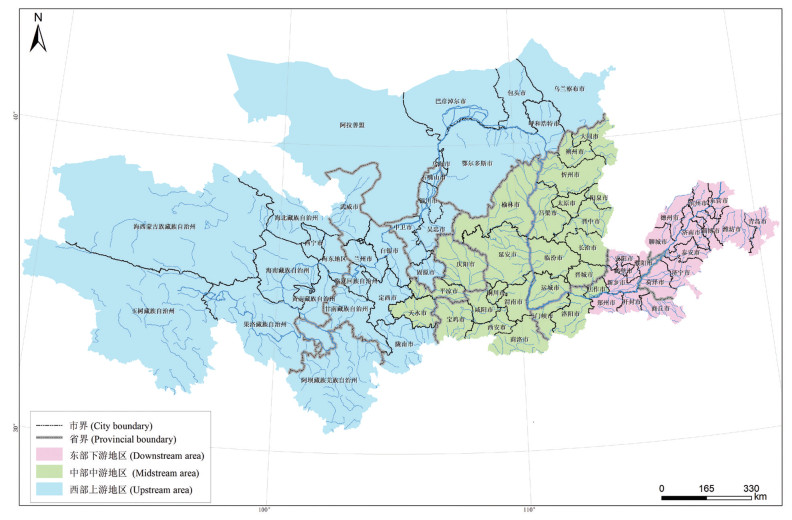
 下载:
下载:
